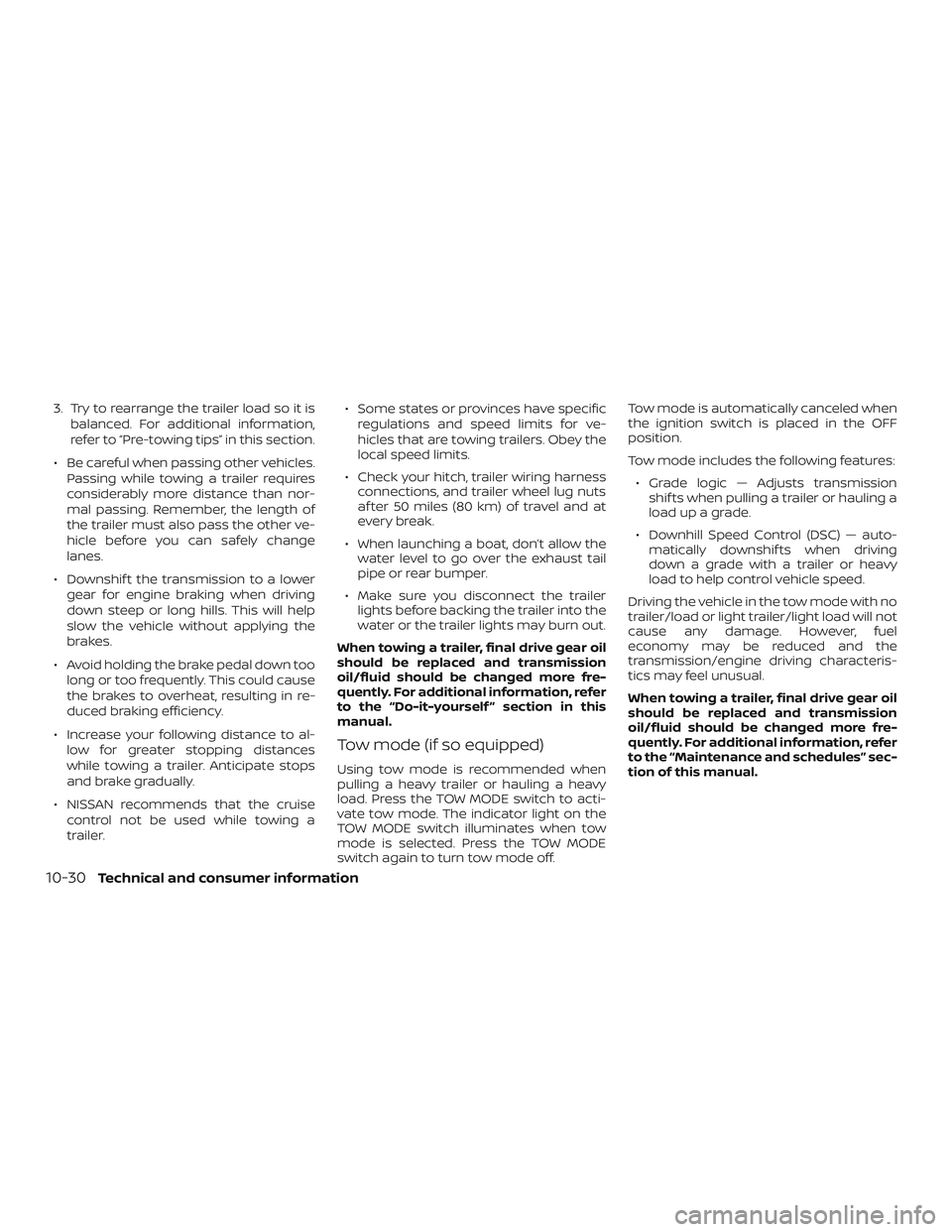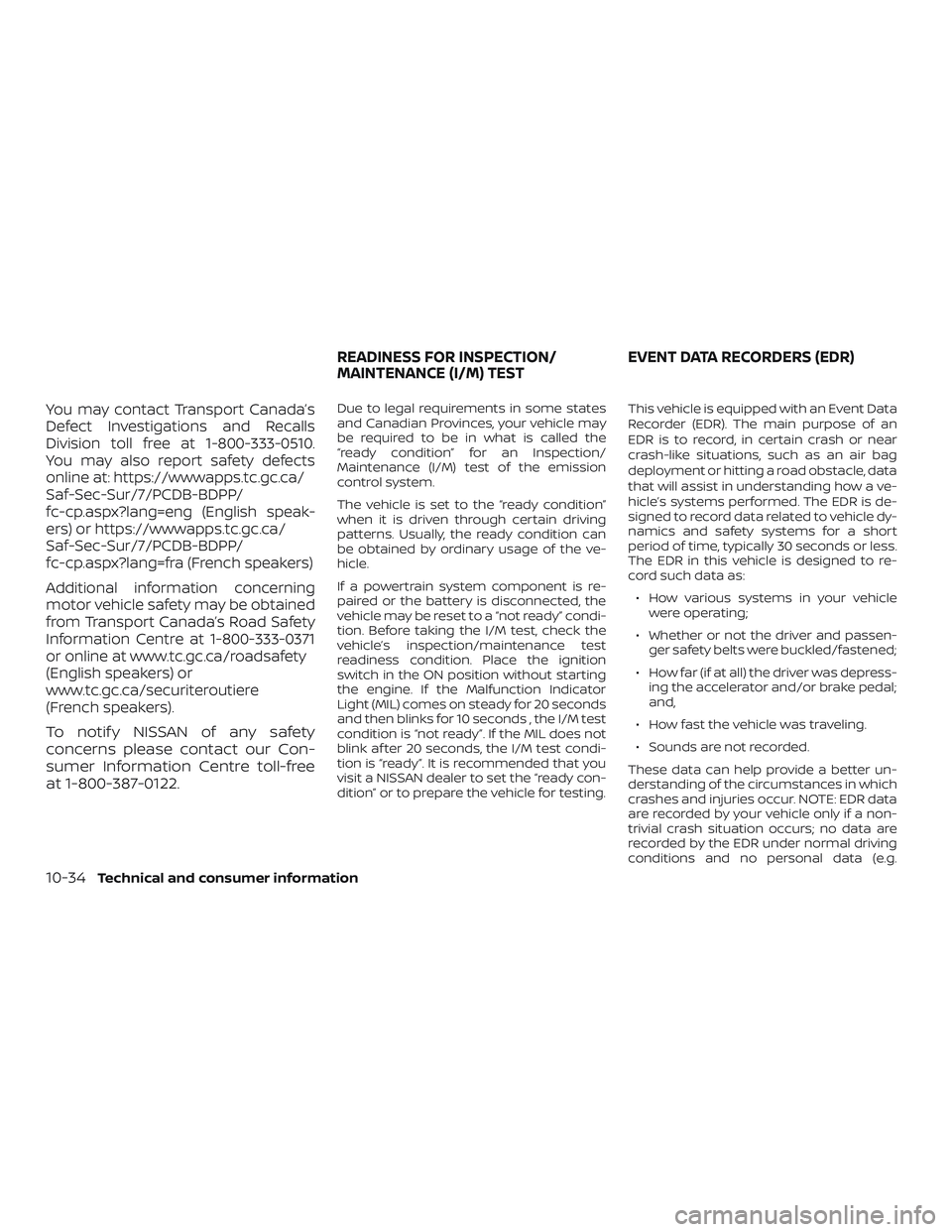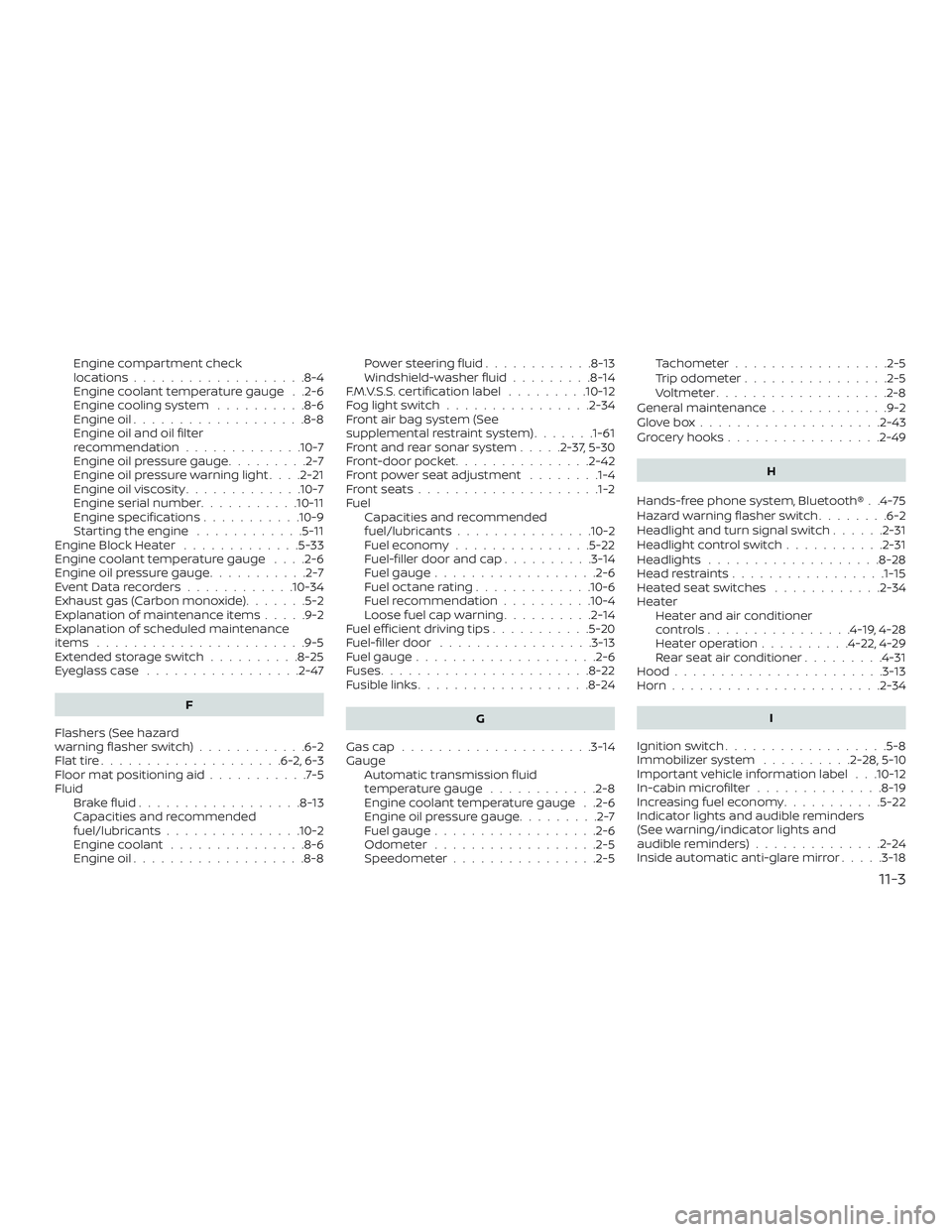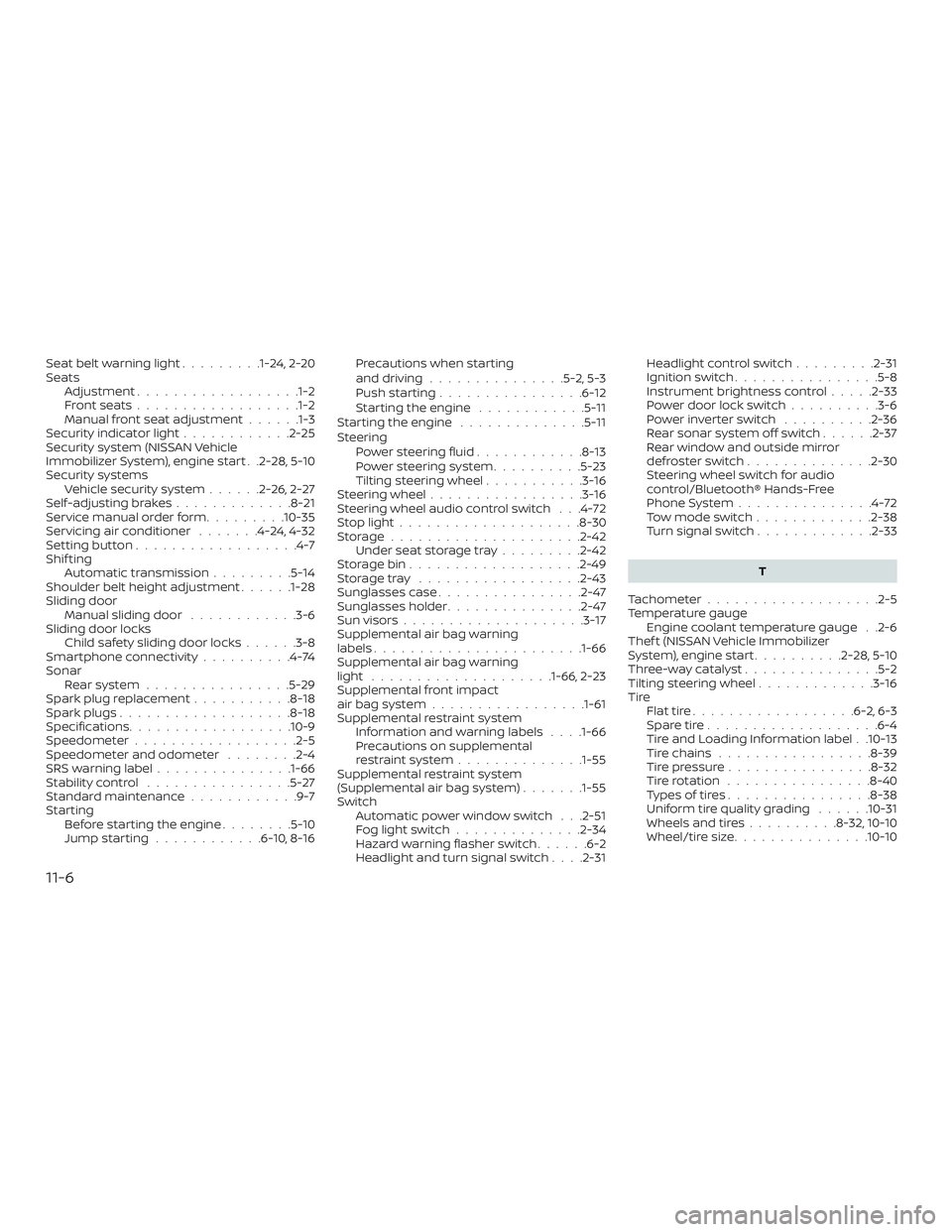2018 NISSAN NV PASSENGER VAN ignition
[x] Cancel search: ignitionPage 411 of 426

3. Try to rearrange the trailer load so it isbalanced. For additional information,
refer to “Pre-towing tips” in this section.
∙ Be careful when passing other vehicles. Passing while towing a trailer requires
considerably more distance than nor-
mal passing. Remember, the length of
the trailer must also pass the other ve-
hicle before you can safely change
lanes.
∙ Downshif t the transmission to a lower gear for engine braking when driving
down steep or long hills. This will help
slow the vehicle without applying the
brakes.
∙ Avoid holding the brake pedal down too long or too frequently. This could cause
the brakes to overheat, resulting in re-
duced braking efficiency.
∙ Increase your following distance to al- low for greater stopping distances
while towing a trailer. Anticipate stops
and brake gradually.
∙ NISSAN recommends that the cruise control not be used while towing a
trailer. ∙ Some states or provinces have specific
regulations and speed limits for ve-
hicles that are towing trailers. Obey the
local speed limits.
∙ Check your hitch, trailer wiring harness connections, and trailer wheel lug nuts
af ter 50 miles (80 km) of travel and at
every break.
∙ When launching a boat, don’t allow the water level to go over the exhaust tail
pipe or rear bumper.
∙ Make sure you disconnect the trailer lights before backing the trailer into the
water or the trailer lights may burn out.
When towing a trailer, final drive gear oil
should be replaced and transmission
oil/fluid should be changed more fre-
quently. For additional information, refer
to the “Do-it-yourself ” section in this
manual.
Tow mode (if so equipped)
Using tow mode is recommended when
pulling a heavy trailer or hauling a heavy
load. Press the TOW MODE switch to acti-
vate tow mode. The indicator light on the
TOW MODE switch illuminates when tow
mode is selected. Press the TOW MODE
switch again to turn tow mode off. Tow mode is automatically canceled when
the ignition switch is placed in the OFF
position.
Tow mode includes the following features:
∙ Grade logic — Adjusts transmission shif ts when pulling a trailer or hauling a
load up a grade.
∙ Downhill Speed Control (DSC) — auto- matically downshif ts when driving
down a grade with a trailer or heavy
load to help control vehicle speed.
Driving the vehicle in the tow mode with no
trailer/load or light trailer/light load will not
cause any damage. However, fuel
economy may be reduced and the
transmission/engine driving characteris-
tics may feel unusual.
When towing a trailer, final drive gear oil
should be replaced and transmission
oil/fluid should be changed more fre-
quently. For additional information, refer
to the “Maintenance and schedules” sec-
tion of this manual.
10-30Technical and consumer information
Page 415 of 426

You may contact Transport Canada’s
Defect Investigations and Recalls
Division toll free at 1-800-333-0510.
You may also report safety defects
online at: https://wwwapps.tc.gc.ca/
Saf-Sec-Sur/7/PCDB-BDPP/
fc-cp.aspx?lang=eng (English speak-
ers) or https://wwwapps.tc.gc.ca/
Saf-Sec-Sur/7/PCDB-BDPP/
fc-cp.aspx?lang=fra (French speakers)
Additional information concerning
motor vehicle safety may be obtained
from Transport Canada’s Road Safety
Information Centre at 1-800-333-0371
or online at www.tc.gc.ca/roadsafety
(English speakers) or
www.tc.gc.ca/securiteroutiere
(French speakers).
To notif y NISSAN of any safety
concerns please contact our Con-
sumer Information Centre toll-free
at 1-800-387-0122.
Due to legal requirements in some states
and Canadian Provinces, your vehicle may
be required to be in what is called the
“ready condition” for an Inspection/
Maintenance (I/M) test of the emission
control system.
The vehicle is set to the “ready condition”
when it is driven through certain driving
patterns. Usually, the ready condition can
be obtained by ordinary usage of the ve-
hicle.
If a powertrain system component is re-
paired or the battery is disconnected, the
vehicle may be reset to a “not ready” condi-
tion. Before taking the I/M test, check the
vehicle’s inspection/maintenance test
readiness condition. Place the ignition
switch in the ON position without starting
the engine. If the Malfunction Indicator
Light (MIL) comes on steady for 20 seconds
and then blinks for 10 seconds , the I/M test
condition is “not ready”. If the MIL does not
blink af ter 20 seconds, the I/M test condi-
tion is “ready”. It is recommended that you
visit a NISSAN dealer to set the “ready con-
dition” or to prepare the vehicle for testing.This vehicle is equipped with an Event Data
Recorder (EDR). The main purpose of an
EDR is to record, in certain crash or near
crash-like situations, such as an air bag
deployment or hitting a road obstacle, data
that will assist in understanding how a ve-
hicle’s systems performed. The EDR is de-
signed to record data related to vehicle dy-
namics and safety systems for a short
period of time, typically 30 seconds or less.
The EDR in this vehicle is designed to re-
cord such data as:
∙ How various systems in your vehicle were operating;
∙ Whether or not the driver and passen- ger safety belts were buckled/fastened;
∙ How far (if at all) the driver was depress- ing the accelerator and/or brake pedal;
and,
∙ How fast the vehicle was traveling.
∙ Sounds are not recorded.
These data can help provide a better un-
derstanding of the circumstances in which
crashes and injuries occur. NOTE: EDR data
are recorded by your vehicle only if a non-
trivial crash situation occurs; no data are
recorded by the EDR under normal driving
conditions and no personal data (e.g.
READINESS FOR INSPECTION/
MAINTENANCE (I/M) TEST EVENT DATA RECORDERS (EDR)
10-34Technical and consumer information
Page 420 of 426

Engine compartment check
locations...................8-4
Engine coolant temperature gauge . .2-6
Engine cooling system..........8-6
Engine oil ...................8-8
Engine oil and oil filter
recommendation .............10-7
Engine oil pressure gauge .........2-7
Engine oil pressure warning light ....2-21
Engine oil viscosity .............10-7
Engine serial number ...........10-11
Engine specifications ...........10-9
Starting the engine ............5-11
Engine Block Heater .............5-33
Engine coolant temperature gauge ....2-6
Engine oil pressure gauge ...........2-7
EventDatarecorders............10-34
Exhaust gas (Carbon monoxide) .......5-2
Explanation of maintenance items .....9-2
Explanation of scheduled maintenance
items .......................9-5
Extended storage switch ..........8-25
Eyeglasscase .................2-47
F
Flashers (See hazard
warning flasher switch) ............6-2
Flattire....................6-2,6-3
Floormatpositioningaid...........7-5
Fluid Brakefluid..................8-13
Capacities and recommended
fuel/lubricants...............10-2
Engine coolant ...............8-6
Engine oil ...................8-8 Powersteeringfluid............8-13
Windshield-washer fluid
.........8-14
F.M.V.S.S. certification label .........10-12
Foglightswitch................2-34
Front air bag system (See
supplemental restraint system) .......1-61
Front and rear sonar system .....2-37,5-30
Front-door pocket ...............2-42
Front power seat adjustment ........1-4
Frontseats....................1-2
Fuel Capacities and recommended
fuel/lubricants...............10-2
Fuel economy ...............5-22
Fuel-filler door and cap ..........3-14
Fuel gauge ..................2-6
Fueloctanerating.............10-6
Fuel recommendation ..........10-4
Loose fuel cap warning ..........2-14
Fuel efficient driving tips ...........5-20
Fuel-filler door .................3-13
Fuel gauge ....................2-6
Fuses .......................8-22
Fusiblelinks...................8-24
G
Gascap .....................3-14
Gauge Automatic transmission fluid
temperature gauge ............2-8
Engine coolant temperature gauge . .2-6
Engine oil pressure gauge .........2-7
Fuel gauge ..................2-6
Odometer ..................2-5
Speedometer ................2-5 Tachometer
.................2-5
Trip odometer ................2-5
Voltmeter...................2-8
General maintenance .............9-2
Glovebox................... .2-43
Grocery hooks .................
2-49
H
Hands-free phone system, Bluetooth® . .4-75
Hazardwarningflasherswitch........6-2
Headlight and turn signal switch ......2-31
Headlightcontrolswitch...........2-31
Headlights...................8-28
Headrestraints.................1-15
Heated seat switches ............2-34
Heater Heater and air conditioner
controls................4-19,4-28
Heater operation ..........4-22,4-29
Rear seat air conditioner .........4-31
Hood .......................3-13
Horn.......................2-34
I
Ignition switch ..................5-8
Immobilizer system ..........2-28,5-10
Important vehicle information label . . .10-12
In-cabinmicrofilter ..............8-19
Increasing fuel economy ...........5-22
Indicator lights and audible reminders
(See warning/indicator lights and
audible reminders) ..............2-24
Inside automatic anti-glare mirror .....3-18
11-3
Page 423 of 426

Seatbeltwarninglight.........1-24, 2-20
SeatsAdjustment ..................1-2
Frontseats..................1-2
Manual front seat adjustment ......1-3
Security indicator light ............2-25
Security system (NISSAN Vehicle
Immobilizer System), engine start . .2-28, 5-10
Security systems Vehicle security system ......2-26,2-27
Self-adjustingbrakes.............8-21
Service manual order form .........10-35
Servicing air conditioner .......4-24,4-32
Settingbutton..................4-7
Shif ting Automatic transmission .........5-14
Shoulder belt height adjustment ......1-28
Sliding door Manual sliding door ............3-6
Sliding door locks Child safety sliding door locks ......3-8
Smartphone connectivity ..........4-74
Sonar Rear system ................5-29
Spark plug replacement ...........8-18
Spark plugs ...................8-18
Specifications ..................10-9
Speedometer ..................2-5
Speedometer and odometer ........2-4
SRS warning label ...............1-66
Stability control ................5-27
Standard maintenance ............9-7
Starting Before starting the engine ........5-10
Jumpstarting............6-10,8-16 Precautions when starting
anddriving...............5-2,5-3
Push starting
................6-12
Starting the engine ............5-11
Starting the engine ..............5-11
Steering Powersteeringfluid............8-13
Powersteeringsystem..........5-23
Tilting steering wheel ...........3-16
Steering wheel .................3-16
Steering wheel audio control switch . . .4-72
Stoplight....................8-30
Storage.....................2-42 Under seat storage tray .........2-42
Storagebin...................2-49
Storagetray ..................2-43
Sunglasses case ................2-47
Sunglasses holder ...............2-47
Sunvisors....................3-17
Supplemental air bag warning
labels ...................... .1-66
Supplemental air bag warning
light ................... .1-66, 2-23
Supplemental front impact
airbagsystem................ .1-61
Supplemental restraint system Information and warning labels . . . .1-66
Precautions on supplemental
restraintsystem..............1-55
Supplemental restraint system
(Supplemental air bag system) .......1-55
Switch Automatic power window switch . . .2-51
Foglightswitch..............2-34
Hazard warning flasher switch ......6-2
Headlight and turn signal switch ....2-31Headlightcontrolswitch.........2-31
Ignition switch
................5-8
Instrument brightness control .....
2-33
Power door lock switch ..........3-6
Powerinverterswitch ..........2-36
Rear sonar system off switch ......2-37
Rear window and outside mirror
defrosterswitch..............2-30
Steering wheel switch for audio
control/Bluetooth® Hands-Free
Phone System ...............4-72
Tow mode switch .............2-38
Turn signal switch .............2-33
T
Tachometer ...................2-5
Temperature gauge Engine coolant temperature gauge . .2-6
Thef t (NISSAN Vehicle Immobilizer
System), engine start ..........2-28,5-10
Three-waycatalyst...............5-2
Tilting steering wheel .............3-16
Tire Flattire..................6-2,6-3
Spare tire ...................6-4
Tire and Loading Information label . .10-13
Tire chains .................8-39
Tire pressure ................8-32
Tirerotation ................8-40
Types of tires ................8-38
Uniform tire quality grading ......10-31
Wheels and tires ..........8-32,10-10
Wheel/tire size ...............10-10
11-6